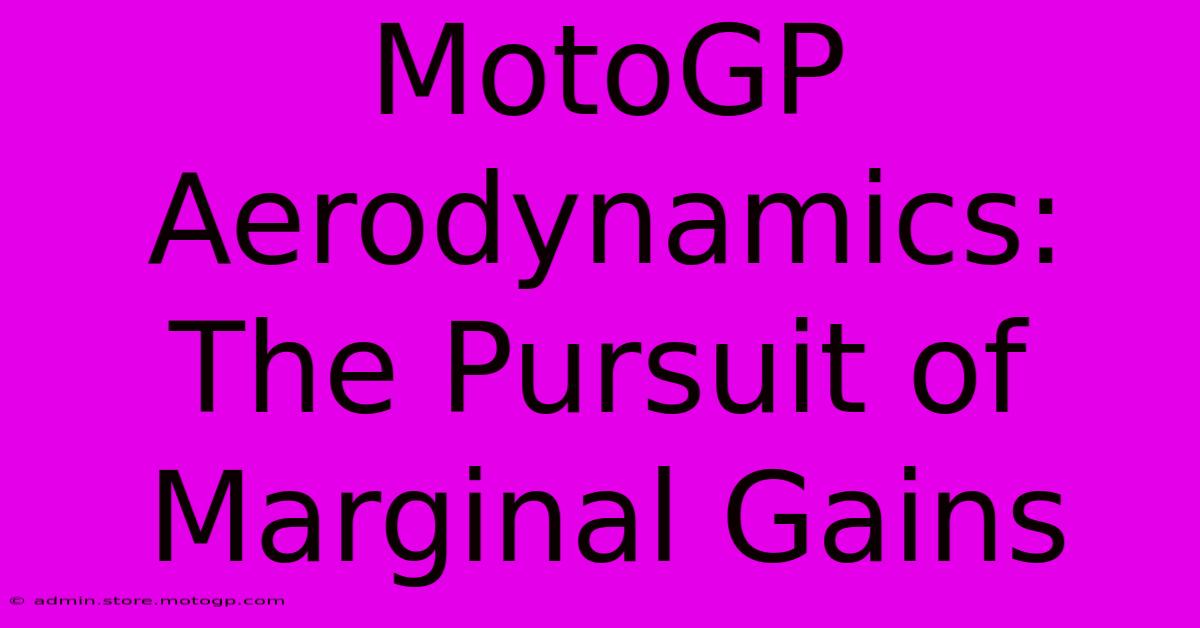MotoGP Aerodynamics: The Pursuit Of Marginal Gains

Table of Contents
MotoGP Aerodynamics: The Pursuit of Marginal Gains
MotoGP, the pinnacle of motorcycle road racing, is a relentless battle for milliseconds. Every advantage, no matter how small, can be the difference between victory and defeat. Nowhere is this more evident than in the sophisticated world of MotoGP aerodynamics. This isn't just about speed; it's about stability, control, and ultimately, winning races.
Understanding the Aerodynamic Challenge
MotoGP bikes, unlike cars, present a unique aerodynamic challenge. They are lightweight, incredibly powerful, and operate at speeds exceeding 200 mph. At these velocities, even minor changes in airflow can have a significant impact on performance. The key areas of focus are:
Drag Reduction:
- Minimizing Air Resistance: Reducing drag is paramount. Every ounce of drag translates to lost speed on the straights and reduced acceleration. Teams meticulously design fairings, winglets, and other components to streamline the bike's profile, minimizing disruption to airflow.
Downforce Generation:
-
Maintaining Contact: While minimizing drag is crucial, generating sufficient downforce is equally important. Downforce presses the bike to the track, improving stability at high speeds, particularly through corners. This enhanced grip allows riders to push harder and carry more speed through turns, leading to faster lap times.
-
The Role of Winglets: Winglets, those small aerodynamic appendages on the fairing, play a critical role in downforce generation. They cleverly manipulate airflow, creating a downward force that keeps the front end planted, preventing wheelies under acceleration and improving stability during braking. The design and placement of these winglets are constantly evolving, with teams exploring innovative configurations to optimize performance.
The Constant Evolution of MotoGP Aerodynamics
MotoGP aerodynamics is a constantly evolving field. Teams employ cutting-edge computational fluid dynamics (CFD) simulations and wind tunnel testing to analyze and refine their designs. Every detail, from the shape of the fairing to the angle of the winglets, is scrutinized for potential performance gains. This continuous improvement cycle is crucial in this highly competitive environment.
Technological Advancements:
-
CFD Simulation: Sophisticated software allows engineers to virtually test various aerodynamic configurations, saving time and resources compared to traditional methods. These simulations provide invaluable insights into airflow patterns and help identify areas for improvement.
-
Wind Tunnel Testing: Physical testing in wind tunnels remains a vital part of the process. This allows engineers to validate their simulations and fine-tune their designs based on real-world data. The insights gathered through wind tunnel testing are crucial in ensuring the aerodynamic performance translates effectively to the track.
The Rider's Perspective: Beyond the Numbers
While the technical aspects are vital, the rider's feedback is equally crucial. The perfect aerodynamic setup on paper might not feel optimal for the rider, potentially affecting their ability to control the machine and push to their limits. Therefore, close collaboration between engineers and riders is paramount. The rider provides crucial subjective data, which helps engineers fine-tune the aerodynamic package to match the rider's specific style and preferences.
The Future of MotoGP Aerodynamics
The pursuit of marginal gains in MotoGP aerodynamics is an ongoing process. We can expect to see continued innovation in materials, design techniques, and data analysis, resulting in even more sophisticated aerodynamic packages. The quest for the perfect balance between drag reduction and downforce generation will remain a central theme in the ever-evolving world of MotoGP. The battle for aerodynamic supremacy will continue to define the sport's future. The next generation of wings, fairings, and other aerodynamic devices will surely push the boundaries of what's possible even further.

Thank you for visiting our website wich cover about MotoGP Aerodynamics: The Pursuit Of Marginal Gains. We hope the information provided has been useful to you. Feel free to contact us if you have any questions or need further assistance. See you next time and dont miss to bookmark.
Featured Posts
-
Moto Gp Austin Dates The Best Time To Visit Austin
Feb 19, 2025
-
Cota Travel Skip The Traffic Maximize The Fun
Feb 19, 2025
-
Get Your Bearings At Cota Formula 1 Austin Map Inside
Feb 19, 2025
-
Experience The Rush Cota Motorcycle Track Days
Feb 19, 2025
-
Cota Store Grab Your Cota Gear Before Its Gone
Feb 19, 2025
